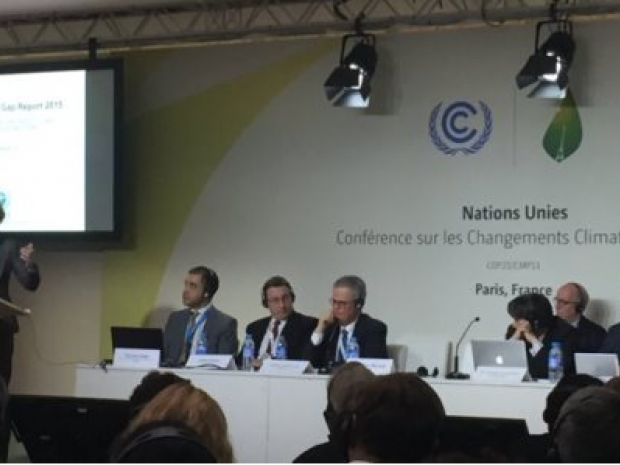UNEP Releases Full Version of Emissions Gap Report
Discussion details
The full Emissions Gap Report can be downloaded from UNEP Live.

UNEP Chief Scientist Jacqueline McGlade at the Emissions Gap Report event: "We need to focus on the intensity of our efforts."
Nairobi, 8 December 2015 - The United Nations Environment Programme (UNEP) has released the full version of the 2015 Emissions Gap Report, which found that the world was around halfway toward the emissions cuts needed to limit global temperature rise to 2°C by 2100.
The report was presented at the Paris climate meeting, to an audience of climate experts, representatives of governments, civil society and the media.
The report presents an assessment of the 119 Intended Nationally Determined Contributions (INDCs) submitted the UN Framework Convention on Climate Change (UNFCCC) by 1 October 2015.
It found that efforts to tackle climate change, including those taken before the Paris agreement and full implementation of the INDCs, could cut up to 11 GtCO2e from projected emissions in 2030.
However, this is around half of the total required to reach the global emission level (42 GtCO2e in 2030) consistent with a likely chance of staying below the "safe" level of 2°C global temperature rise by 2100—bringing the prospect of increased negative climate impacts.
In an earlier statement, UNEP Executive Director Achim Steiner said, "The current INDCs, combined with policies over the last few years, present a real increase in ambition levels and demonstrate an unprecedented commitment and engagement by member states in tackling this major global challenge.
"The INDCs assessed in this Emissions Gap report signal a breakthrough in terms of international efforts to bend the curve of future emissions. While in themselves not sufficient to limit global temperature rise to the recommended level of 2°C this century, they represent a historic step in the direction of decarbonizing our economies. However, in order to close the gap it is essential that the Paris Agreement adopt a dynamic approach in which ambitions, the mobilization of climate finance and other forms of cooperation can be adjusted upwards at regular intervals."
The full Emissions Gap Report can be downloaded from UNEP Live, along with a breakdown of the INDCs by country.
Log in with your EU Login account to post or comment on the platform.